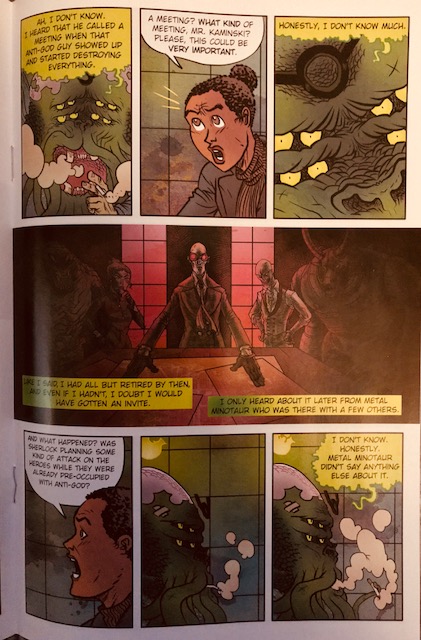Branching off from his much-loved series Black Hammer, writer Jeff Lemire (Essex County Trilogy, Black Hammer), brings us new tales of monsters and superheroes in Sherlock Frankenstein (Dark Horse). With art, colors, and lettering by the incomparable David Rubín (Rumble, Beowulf), Sherlock Frankenstein combines mystery and horror, with sarcasm and sensitivity, and it’s sure not to disappoint.
At the onset of the story, we get a little backstory as to what happened to Black Hammer in previous events. Black Hammer (Joe Weber), along with his superhero friends defeated a cosmic entity known as the Anti-God, but in the aftermath of the battle, the Black Hammer, along with all of his super-friends, disappeared. Lucy Weber, daughter of The Black Hammer and investigative reporter, sets out to discover the truth behind his disappearance. The answers are possibly lying within Spiral City’s insane asylum where the super-villains, and Black Hammer’s arch-enemy, Sherlock Frankenstein, reside.
Not having read Black Hammer before, I was concerned I might be clueless as to what is going on in the story, but according to Lemire, “The last thing I want to do is exploit the fans of Black Hammer with needless spin offs or tie-ins that they have to read to get the whole story. So, these new miniseries, like the regular ongoing Black Hammer series, will stand alone and tell complete, self-contained stories.”
We don’t get a ton of character development for Lucy in the first issue, but the story does a good enough job keeping the reader interested in the events as everything plays out like a mystery. Lucy uses her knowledge and experience as an investigative reporter by first interviewing the supervillains about their master, Sherlock Frankenstein, and eventually learning more about her father’s disappearance. By issue three we begin to see how much of this is weighing on Lucy’s conscience when she dreams about being a little girl waking up to see her dad do battle with the Metal Minotaur (who turns out to be a woman) on television. Only for her dad to start talking to her through the screen, telling her she needs to find Sherlock Frankenstein.
There were some unexpected scenes of legit sensitivity, and eagerness to talk, when it came to the supervillains when they spoke to Lucy that I thought was a nice touch. It gave the supervillains character depth we don’t get from anyone else. Halfway through issue two, you almost get a feeling with all of the supervillains hatred towards Sherlock, and Metal Minotaur’s unexpected respect for Black Hammer, that the superheroes will end up helping Lucy defeat Sherlock and find her father. But as in all good mysteries, things are not always as they appear.
I like how the dialogue is simple and easy to follow. I particularly enjoyed how Lemire wrote Sherlock’s character, sort of like using Godzilla sparingly until the climax. His name is very front and center, but we only get a small sample of him in action.

Rubín’s talent has so many ranges it’s incredible to know that one person gave these characters such visual depth. His use of colors is awe-inspiring. Rubín has a way of making everything visually stunning, yet simplistic all at the same time. Anti-God is a giant walking shadow with red eyes, and Sherlock Frankenstein looks like walking version of Dr. Strangelove and Nosferatu wrapped in one. My only criticism (and it’s a nitpicky one) is of the word bubbles. By page three I noticed the word bubbles are quite large with large fonts. I don’t mind, it makes it easy to read, but it does distract from Rubín’s glorious art. And I wish MO was written M. O. for clarity.
Sherlock Frankenstein is like a superhero comic with characters from the reject bin. It leaves you wanting to know what’s going to happen next, which is the goal of any comic series. Sherlock Frankenstein 1-3 are available now with the last issue of this four-part miniseries to drop January 24, 2018. “The World of Black Hammer has become my favorite place to be,” Lemire concluded. It also could very well be mine.
@EricOnkenhout